- Home
- > Nature online
- > Life
- > Human evolution
- > Humans in Britain
- > What was Britain like?
- > Britain's changing fauna
Primary navigation
Britain's changing fauna
Animal remains found by archaeologists help us understand changes in the British environment over the last million years. Mammoths, bears and lions are long gone, but others such as horses and deer are more familiar.
Early Britons hunted some of these animals for food, wore their skins and made tools from their bones and antlers. Others posed threats to humans, competing with or even preying on them.
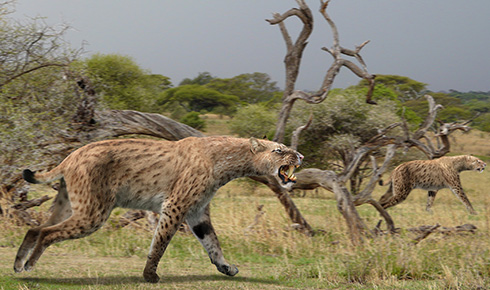
Sabre-toothed cat, Homotherium latidens
In Britain from about 700,000 years ago (exactly when they disappeared is contentious)
Carnivores such as sabre-toothed cats were ferocious competition for humans in ancient Britain. Streamlined with long legs, they could chase prey over long distances. These deadly predators pierced the throats of their victims with long upper canine teeth.
© Roman Uchytel, prehistoric-fauna.com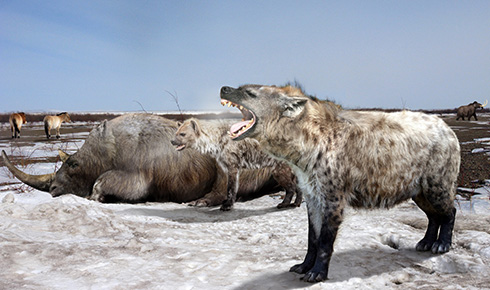
Spotted hyena, Crocuta crocuta
In Britain between about 700,000 and 25,000 years ago
Butchered and gnawed animal bones reveal hyenas scavenged leftovers from human hunts. Ancient hyenas were much larger than those living in Africa today. They were once widespread throughout Europe.
© Roman Uchytel, prehistoric-fauna.com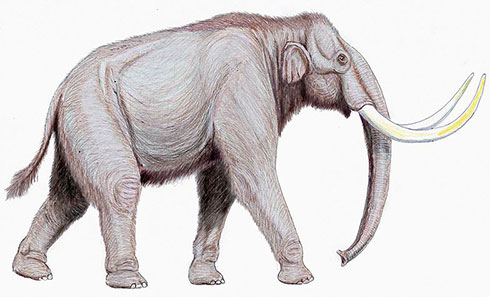
Steppe mammoth, Mammuthus trogontherii
In Britain between 700,000 and 200,000 years ago
These were the largest of all mammoths, reaching up to 4.5 metres tall at the shoulder and weighing up to 10 tonnes. They may have had thick fur and smaller ears as adaptations to the cooling northern climate.
Image by Creator:Dmitry Bogdanov (dmitrchel@mail.ru) under CC-BY-3.0 license, via Wikimedia Commons
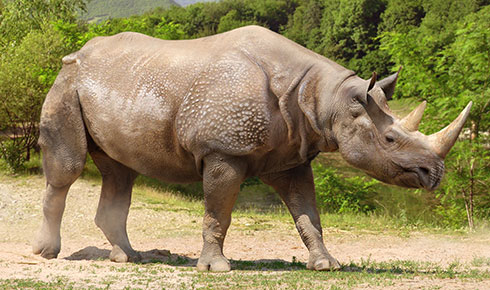
Rhinoceros, Stephanorhinus species
In Britain between at least 700,000 and about 90,000 years ago
Half a million years ago, Boxgrove in West Sussex was home to a population of the human species Homo heidelbergensis. Rhino bones were common among the remains of animals they butchered there.
Extinct ice age rhinoceros species were similar to the living Sumatran rhinoceros and lived in woodland and open grassland environments.
© Roman Uchytel, prehistoric-fauna.com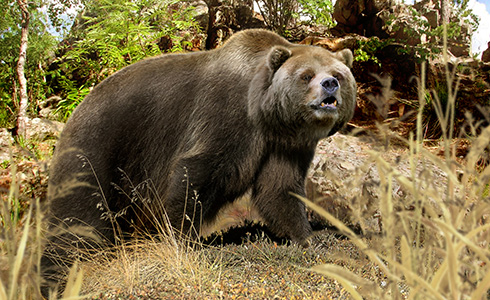
Cave bear, Ursus spelaeus
In Britain around 400,000 years ago
Reaching 3.5 metres tall, these intimidating beasts were in fact mainly vegetarian. Many died during hibernation, their bones preserved in the caves that became their final resting place. They became extinct in Europe about 28,000 years ago.
© Roman Uchytel, prehistoric-fauna.com
Straight-tusked elephant, Palaeoloxodon antiquus
In Britain between 600,000 and 120,000 years ago
Few animals survived in Britain between 475,000 and 425,000 years ago as temperatures plummeted and ice sheets smothered most of the land. When temperatures rose, animals returned, including some now associated with tropical regions.
Straight-tusked elephants browsed for food in Britain’s open forests. Now extinct, these massive beasts were larger than modern elephants.
© Roman Uchytel, prehistoric-fauna.com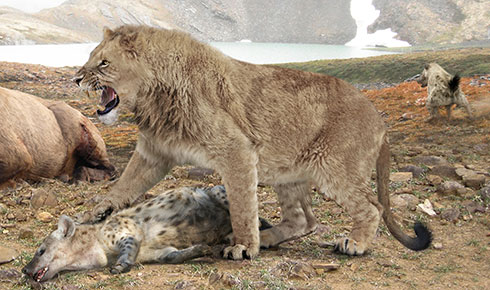
Lion, Panthera leo
In Britain between 700,000 and 40,000 years ago
Lions were one of the top carnivores in ancient Britain. These ice age beasts were the largest of all cats, 25 per cent bigger than modern African lions. Herds of large mammals such as aurochs and bison made abundant prey. Occasionally, so did humans.
© Roman Uchytel, prehistoric-fauna.com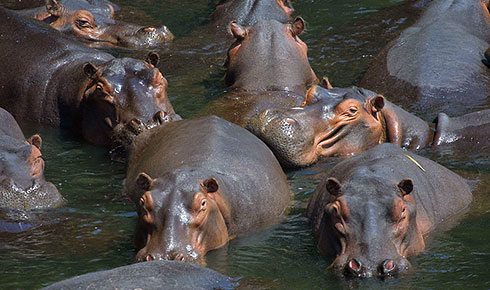
Hippopotamus, Hippopotamus amphibius
In Britain around 700,000 and 125,000 years ago
On occasions, when the climate was warm enough, hippos wallowed in Britain’s lakes and rivers during the day and wandered in search of plants after dark as they do now in parts of Africa. The northernmost evidence of hippo habitation comes from Stockton-on-Tees in northeast England, but they may have moved even further north.
Image by Paulmaz at the English language Wikipedia under CC BY-SA 3.0 license, via Wikimedia Commons
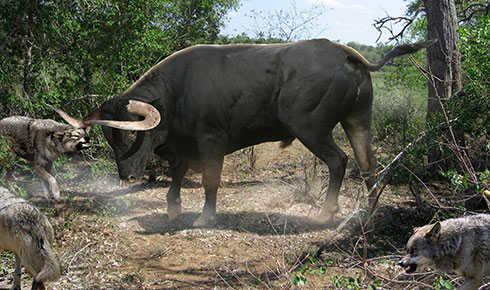
Aurochs, Bos primigenius
In Britain between about 400,000 and 4,000 years ago
Herds of aurochs were once abundant during warm periods. Extinct since the 17th century, their descendants are domestic cattle bred for meat and milk.
Unlike similar bison surviving today, aurochs did not make long seasonal migrations. They lived in open woods and rich grasslands that provided plentiful food.
© Roman Uchytel, prehistoric-fauna.com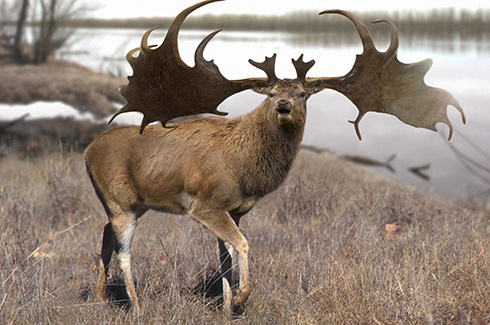
Giant deer, Megaloceros giganteus
In Britain between 400,000 and 12,400 years ago
Giant deer were among the biggest deer that ever lived. The largest had antlers spanning up to 3.5 metres. Although these were an effective deterrent to some predators, they were hunted by both Neanderthals and Homo sapiens.
© Roman Uchytel, prehistoric-fauna.com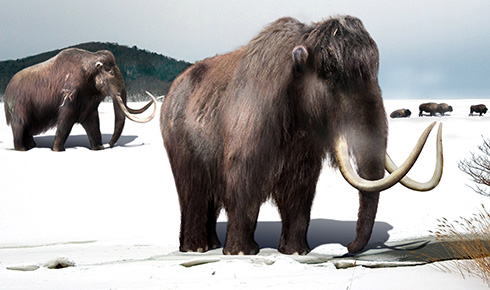
Woolly mammoth, Mammuthus primigenius
In Britain between 190,000 and 14,000 years ago
These large robust herbivores withstood the bitter winds that swept across British grasslands 60,000 years ago. Early humans and other predators pursued these ample food sources to ensure their own survival.
Flint tools made by Neanderthals were found with the bones of 11 woolly mammoths at Lynford, Norfolk. This suggests the Neanderthals butchered and perhaps hunted these animals.
© Roman Uchytel, prehistoric-fauna.com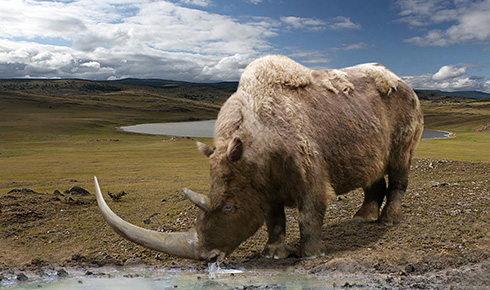
Woolly rhinoceros, Coelodonta antiquitatis
In Britain between about 190,000 and 36,000 years ago
Head low to the ground, the woolly rhinoceros had teeth that were well adapted to grazing tough grasses. Wear on their enormous horn suggests these rhinos may have used it to sweep away snow to get to their food.
© Roman Uchytel, prehistoric-fauna.comRelated information
- Quaternary mammal research
- Mammoth extinction due to climate change news, Aug 2010
- Mammoths: Ice Age Giants
External links
Toolbox
- Contact and enquiries
- Accessibility
- Site map
- Website terms of use
- © The Trustees of the Natural History Museum, London
- Information about cookies
- Mobile